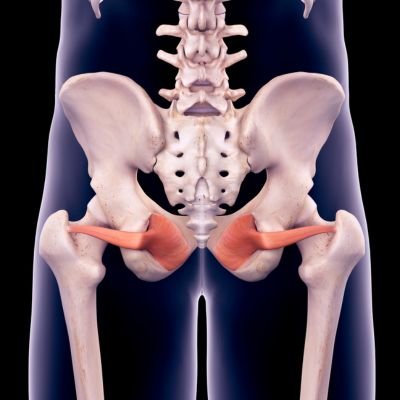Muscle Breakdown: Obturator Internus
Table of Contents
What Is the Obturator Internus
Our hips allow us to produce many powerful movements, hold the weight of our bodies and bear the force from the muscles in our legs. With much of the body’s movement and stability coming from the hips, we need to make sure that the hip joint is strong and healthy.
The Obturator Internus is a muscle in the deep hip that functions to stabilize the hip and produce various movements at the hip joint. Small muscles like the Obturator Internus may seem like they have an insignificant role compared to larger muscles in the body, however the Obturator Internus works together with other muscles in the deep hip to ensure the stability and optimal functioning of the joint. Keep reading to learn more about the Obturator Internus and the role it plays in the body.
Obturator Internus Muscle & Cadaver
The Obturator Internus muscle itself is shaped like a triangle and is located in the lateral wall of the pelvis. The Obturator Internus muscle is considered to be a deep muscle in the hip joint. This means that there are no other layers of muscle beneath it, but there are layers of muscle above the Obturator Internus. Muscles that are above the Obturator Internus are referred to as superior to the Obturator Internus.
Obturator Internus Function
The Obturator Internus has a few different functions. These functions include,
External rotation of the hip
Abduction of the hip
Stabilization of the hip joint
Obturator Internus Action
The Obturator Internus helps our bodies to perform many actions such as walking, running, jogging, swimming and many other sports and movements. The Obturator Internus is one of many muscles in the hip that the body relies on for our everyday activities and well-being.
Obturator Internus Origin
The origin of the Obturator Internus is the surface of the Obturator Membrane.
Obturator Internus Insertion
The insertion of the Obturator Internus is the Greater Trochanter.
Nerve to Obturator Internus
The Obturator Internus is innervated by the Nerve to the Obturator Internus.
Obturator Internus Pain
Pain in the Obturator Internus can manifest itself as pain on the sit bones and pain in the groin or gluteal region. Obturator Internus pain can often be mistaken for IT or Hamstring pain, so it is important to seek advice from your physician immediately if you are experiencing pain in this muscle.
As the Obturator Internus plays a role in many of our everyday activities, dysfunction of this muscle can be debilitating so an appropriate treatment plan is essential for returning this muscle to its optimal state. Pain in the Obturator Internus can be addressed through stretching, dry needling or trigger point therapy.
Obturator Internus Trigger Point
Many muscles have a trigger point that can be manipulated to help release tension in the muscle. This is done through gentle circular massage and other techniques to locate and press on the muscle’s trigger point.
A Registered Massage Therapist is the best person to consult if you would like to release the trigger point of the Obturator Internus.
Obturator Internus Release
If you would like to release the Obturator Internus, you need to locate the muscle’s trigger point. As we mentioned above, the best person to do this would be a Registered Massage Therapist. They will most likely place you in a side-lying position with a pillow in between your knees to access the Obturator Internus.
Obturator Internus Pain Sitting
Sometimes, when sitting down we can feel pain in our sit bones. This pain can radiate and be misdiagnosed as an IT Band, Hamstring, Piriformis or Sciatic issue when the pain is actually originating from our Obturator Internus. We can feel pain in the Obturator Internus for a variety of reasons, the most common being overuse of the muscle. It is critical to see a physician if you are experiencing pain when sitting so they can accurately diagnose the source of your issue.
They will perform manual tests, and if warranted diagnostic imaging to confirm their findings. Once your physician has determined the source of your pain, they will be able to provide you with an appropriate treatment plan to reduce and/or eliminate your symptoms. Treatment is usually conservative and consists of rest, ice, heat, anti-inflammatories and stretching.
Obturator Internus Attachments
The Obturator Internus originates from the Obturator Foramen. This origin point of a muscle is generally closer to the midline of the body and does not move with contraction. The insertion of the Obturator Internus is the Greater Trochanter. The insertion point of a muscle is generally more distal and further from the midline of the body.
Obturator Internus Syndrome
Obturator Internus Syndrome refers to a dysfunctional Obturator Internus. This syndrome can arise from overuse of the muscle, injury, muscular imbalance and poor movement patterns. In severe cases, the Sciatic Nerve can become trapped. Obturator Internus Syndrome is related to Piriformis Syndrome as it also involves a pressured Sciatic Nerve.
Obturator Internus Massage
A Registered Massage Therapist will be able to massage the Obturator Internus. Keep in mind that the Obturator Internus is located in a very personal area of the body. Your therapist will most likely ask you to sign a form noting your consent for them to treat this sensitive area.
Obturator Internus Tendon
The Obturator Internus tendon inserts into the Greater Trochanter of the Femur, along with the tendons of the Inferior and Superior Gemelli.
Obturator Internus Stretch
There are a few stretches that you can try that will target the Obturator Internus. Here are the stretches:
Standing Stretch
Standing Stretch
Rest your knee on a table so that your shin is coming across the body. Your ankle will be in line with the knee and on the table as well. While keeping the back leg straight, lean forwards as far as you are comfortable. Hold this position for at least 30 seconds.



